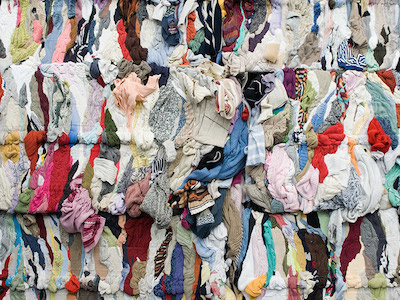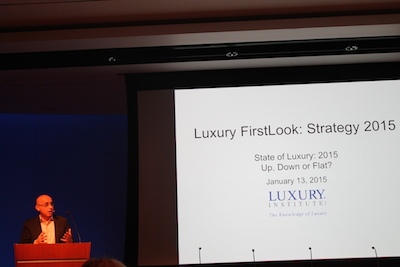NEW YORK – Predicting trends for the upcoming year can be arduous and even economists, investors, marketers and agencies are often proved incorrect 12 months later as year-end results are released, according to a discussion at Luxury FirstLook: Strategy 2015 Jan. 13.
At fairs and farmer’s markets guests are often asked to participate in a game that predicts the amount of coins or beans in a glass jar and the individuals tend to be wrong, but the average of all these predictions were often close to the actual number. At Luxury FirstLook: Strategy 2015 guests were similarly asked to discuss their predictions for the upcoming year to forecast the year ahead.
“We have lifeguards because rip currents can take people out to sea, even if they are good swimmers,” said Milton Pedraza, CEO of The Luxury Institute, New York. “Even if we are skilled professionals it is important to look those for rip tides even in great environments.”
Luxury FirstLook: Strategy 2015 was organized by Luxury Daily.
Collaborate and collect
Mr. Pedraza asked guests at Luxury FirstLook 2015 to discuss three questions in small groups for 10 minutes and then to collaborate with the room. Guests included brand marketers, agencies, publishers, researchers and experts in the luxury industry.
The first question asked guests to decide if the luxury market will be up, down or flat in 2015 in both the United States market and the global market. He asked for a percentile number for the trend.
Around the room the general consensus was a very moderate increase. Most groups suggested about a three percent increase in the luxury market this year.
Mr. Pedraza also inquired about the threats and opportunities in luxury this year.
Threats were overwhelmingly thought to be the geopolitical events. In the shadows of the recent terrorism attacks in Paris, experts in the room showed concern for the unforeseen threats on major cities in the world.
Another threat is market competition. Some groups discussed the mass homogenization of luxury and the emerging high-end, "new luxury" brands that are slowly flooding the market.
One more threat discussed was the use of technology. Brands often have a system of collecting data, but using this information is often stagnant. Another threat is the rise of technology and understanding mobile commerce.
Technology is also an opportunity for luxury. Brands can take data and integrate it throughout their internal and consumer-facing practices.
Emerging consumers will be an additional opportunity this year. With the drop in oil prices consumers that were previously aspirational will have more money to spend on luxury goods. Also, the aspirational, burgeoning consumer in emerging markets has the opportunity to be educated and gain an understanding of luxury.

Stella sustainable fabric
Several groups also mentioned the desire for consumers to understand the who, what, why and the heritage of a company. Many consumers are more conscious than before about the manufacturing process of a product, so giving social transparency can invite consumers who are cognizant of the quality and engineering behind a brand to understand where, why and by whom their item is crafted.
Mr. Pedraza’s final question asked about the unforeseen events that might blindside the luxury industry.
Around the room groups generally agreed that the unanticipated events are similar to threats, the geopolitical events and the stock market.
Be careful of currents
Mr. Pedraza also provided his own predictions for 2015. He, like the audience, suggested a flat or single digit increase in the luxury market this year and suggested that the U.S. market might be slightly higher.
He cautioned against the “rip currents” that might catch the luxury market off guard. For instance, the oil market might help increase pocket money for consumers, but in places like Texas or the Middle East that are dependent on oil, the decrease will likely harm local markets.
Mr. Pedraza suggested his three recommendations for the year in the luxury markets: store optimization, channel alignment and marketing effectiveness.

Mr. Pedraza at Luxury FirstLook 2015
Store optimization is about the relationship that is built between the brands. The sales people in-store may not sell something today, but the relationship created with a consumer can spark a long-term bond between the brand and the individual.
Channel alignment involves brands integrating every part of their company. Data lets brands see who is buying in just one channel and who is a multichannel purchaser. An online relationship management team can meld the online touchpoints to match the in-person experiences consumers have when shopping in-store.
The final suggestion was marketing effectiveness. Brands need to realize the inefficient tendencies and sectors and eliminate them. Marketing teams should be held accountable for generating store and online traffic, not brand awareness.
Past and future
Looking out toward the year ahead can be daunting, but those who adapt with the technology, emerging markets and positive influences in manufacturing will likely see positive responses.
Campaigns that used these techniques saw positive responses in 2014.
For example, the Fairmont Beijing partnered with automaker BMW to offer guests emission-free transportation through the new electric i series.
The alliance will bring both brands together to present guests with the opportunity to ride in the i series and experience Beijing. An eco-friendly package will likely interest environmentally conscious guests as well as BMW enthusiasts (see story).
Similarly, French atelier Saint Laurent Paris’ beauty brand YSL Beauté enhanced product demonstrations at its cosmetic counters with the introduction of Google Glass tutorials.
The beauty brand has rolled out Google Glass tutorials at retailers such as Bloomingdale’s and Selfridges to temporarily personalize the in-store experience through technology. Brands and consumers alike have struggled to incorporate Google Glass into everyday life, but the functionality of the technology in an in-store setting is hard to dispute (see story).
Predicting the future is nearly impossible, but collaborating and understanding the thoughts of others across multiple industries and positions can effectively create an understanding and marketing plan for a brand.
“Collective wisdom can be far better than any one speaker,” Mr. Pedraza said.
Final Take
Nancy Buckley, editorial assistant on Luxury Daily, New York
{"ct":"sTCGG1L8F9byCQXRK9AMQatxZroHh4nrJVxwhiU8oZNoz2+NYDBEPMWdl1W8pBuVual\/x6nvlmdIDZQpnaPMpm++V26xg+YW+kawbGSkNLSDWbX\/iyrtelij+1ePpuv+SBQEhiu3j+xzngtg1Sur2Gr7ipNTLj+YqwUBeujVC7ROg2YOriSbzTrBbSynnJjiCtaphFEo4anDoWvVn7vH3hZ+3CaAcp665epw\/XH6q4ZNutMGHXMog14mK8GcRz0iZj57PKVLkBEh1YMTWHKETj8pvOzJS4BAemmHqJ532\/cHpNhvztANExyoW3wYlTMuGAS2Zis8k3SeZ6+mlzcjM1EEjIFts90mdvQmpaycxY4VuGIKVT+KLi+UxXasTynqTlHcCV5sgFI1iCFhueEr\/2Nc9ZYBBW5ICFgIe2N+uQpr5gEp0FFGGGQzUdkQPiGLj8xJ8SILeCZhBlVykKutiTHSMG5Suo4ImYztlSa8cr4RcQJWevWCUMWb2sIdb5p8Y6az1huLI4o3FtlaTA36QEPZbw0yBTgpMjWb+VotQURAP\/vIj2WMkyWEk16uxYKjZ8\/KUsq27AtiLV41BfpfUzrwtOSSvIdDWJ1kIDxKD7QU+xpiyuq5FFfjEHXhaPb81sO2KzBM5c1BsHjFoa6+XVSs5yx5lA5Zfb5zz0jfZLFV2i36EnH4gPons3dEr3k+Zz1SDuqJT0jv5aOvLaPQRj25nkuTSvuK96rvgrHUIKSKdBz5vuMIIaTyanUvoBQZQ5rR4GoDHL1qqzfeYAeH+3kozU9PLOYITwxID491U1PKjJuk+GjKjy7aBev8WKUzAJenVb4XJAFqRRDTY8RTeyNvoEHURl2lG8+FVU6R3bAGa3phH2Tjfmqza8A+RwkurzemZo33fWQ12RKHm5K53HwKrxw1galExEgW4TV\/TW7soFGwf6vsOxhhQVtOr2vNiyV9Gqe6r2FJ3MVXjjF7n0jaZY\/yKgziBHXWAg1fEllk9zHdHzaFQtMv7n0SD+q+Mxz5QjL\/z9f4bbnCzIyw3i79IaFy7A9tPKPLwtZJqjQ37V4SppecIFqZ33xtZH9SjJ+0O2jJEiJ4eMH7\/S15xl\/mS7LT46dLk4wUL7VFv506WPMijDvWRhM4xrmTf9P3LpEpJs0ZlpNU+niAOHSTey59zaYBugpJHgo99SjUXeltvpcakSzZjkqD\/+TjPl2fd\/ZiwYAmYN5G64bhREizB49HLZTy78KRZ2KwJmmQ9L4ht9JqLxKN+VBZrPFNSs850ZXtmwXDrDcl09\/MiNz1kYxm3reLUaBvsf7HhqZLzeFgOa57NESRWyO1CBNFrgfD45Qu9DN+mTyy9dYJGGtg5hcIy+IziZMRxSZhxTlZbNyJt7ahtVnm7frtq\/S4uPxrBgv3fDcWZsK1s1HMmnROvVfen1+OUe6bqVe2WZlhP59W27BRAnAJ8K8ZA+XA7nkJSnixzrFjLAXdRaPv\/nZ6WuyZR3GVV9REXHkVHOxPCdjeGvwBvTERawz\/prH06ynlg6scfUYx+0WssezVo5Y3k5sJLucQpdF24lndvcDBheShU6WlW3+GH8jFVPl2NXmN\/kBH9BP6aEHPGh3cmRuqe8uvq4CcLhoCN1efDBt07d5S2xlNZ1c7Gz1TeiuJ3mvoRXgqY+i78S7EWklGcszYvy4bbLSCr9i3nn0V1Qfo\/meVm1w9tce4OzWKix39xN1WbrANS9auK4tlvWc0gN2GHQKu5J1J\/U8Tqkhi7DLDhBkDJg8+QDlzYQK+HyQZbErLUfeLa+hJx1mTn2Am2fmsBe0sfTPJKIvohe4zJASZ9Chbc0rNh4s2wx3wEH48nQMXtKhxv2xvWefAtYlEDAz8OWVS66Ct9o3azcaheHZ4yCggDaJ9MHLeojSJQugILCPAzREgoW5Gv9gCr+\/r4y8GN+njigiquC6on+wbLAAzV9YnQef8TN0wyFg0i\/KlP0E5zGJAZ3Uj1LfcBKM9\/ZGtBLRM1GzHW7hm19NK8MtSIjwfeL0C6n6xnKvhCR7MEyDadlv6s4gHmkYRl\/2vwzFqYsPcST0QziPi2unGZCk60EyfMcxuND56cccYGHhUAAJThtdZ5glr7zbkmaRXcO6poxiSJmymPgAX9CuCbDR1sdl2wtvH\/f1kC1gQ3z1JL+efDkXzOK7GIuoS4Mn6QhW9tMf\/+EdBXzbiJ0paes0\/k+zWbBWa\/9LwrH+0PIN2TaF5nIvxSCAQ+RHkSvRlKV4p1TmZmT3jGFfhcgsaHmEwyPpP6feQsIdLNMn3BDJ3yzrVyGBox3IvcUcwybgnIJb3zjk9rq0gtemOGhZFQSqMhgS8s0jm8+S\/hoOlzC24YM0UxLsa0jfjwAlhABXCh2YfW2dCFLAnsRXWTy2EaD3yEKUJGoYBA3vJJms1JowG2sok2i0djiGi7GAPOu6iyZTIxqV5qSSSvEck3qjP1cLQ+t95hs4HRsk\/KUaSoaThdVOV5zKFTqULku3IFJ5vbnymv7V5gGrgwVZOr7UbFXKdyRZEAYLKCD\/Vr0QlCjOpl536\/bO1mH9mGX80dCkeC6cr8cfjip7NMzCt8eW3XAb+sf3+XVlb9JAapxjfZnblh7pls\/6yf\/x0BXF5OQCq\/7UeDl0X75uvs4rZkZCqiwkyYeKob1sju8f5InSr7HXVzti4pGqineCsgn6fiKq+uKlo868Eafann59E1T+9unCWajpoa4A4rdjvU5V8NUrO\/4vE\/9yWo3wa57szbO8RMJcRuPApxBFzlmJKnZIlcv5h27GUoBn8NvKFZlZDW1qz6\/dW4xZuqYHNJyk4nG+42Bgu56StFPQUxQ+YYrUfRsovPovO\/Zx4pWvxVi4ZaXggDO1JgtLOwCKgsycv9ePKDL\/7U4b3lnrnph7UcpixAtDlsN9Kq6H3jhZY5ZVjm8vBKayJU1hRSVemsBFemsmvzTR+7AYfvsUkEVZMoXQT4OUEszb\/4MInTvMsNcfttqBg6sbpjDJswa8gDLn2SbSDYmRTVNgnUpEsD8L6ePK0EcqTxFErFMhWTYerzJLptbvMMAW0QYTckjYJxNBdsLPSoD89bMjg1pS53ff8Ufig3ddvXyU1ATKdb8+wnsyX6Uuh9wKwDAxhnfDYO62IvrYxRd4OK1+XA1m+4hcSMAKpX6MGcBPQgAmsHEDLw3s1F9MBT3tDyRJ1jQ33zc+4vm\/piG5BhqYHBq8OZ4G20pZVhwA3Z00uWfbc7OI8HVodl+alRTN9SzQHjftG3xsc4EYqBm4rjqyH4ulrV0qEMDiwEOV1u5TaYlyt7a\/vPQFfYBjwspK8iSH+2on0QPnnZviZTx\/OOCQfZgfsOAiyorfhyIyySRDV8\/wGK3c\/jdCjZxyERkwAJPBSm4m2Fu6ayHdBa7r1tcjonld08Bq1QClwH9ZmmKd6OLfeEW9V95quozgL6zFFnDCy\/IZOv7ZhX6OZGWJ65lY+CvCIHH3eVFoeZi54XLtgOpsq6yOm2Ne3jqUmlv9tn1mCcVs4qlUWDJOulK+EfNTzrhq7md7kQFzWAhyGuWc8zAdZI8C9mIVHJ\/ofOpyI+ICxUosq1wvRF9NRH27VbvJxk5\/BX\/g5ml7SuS\/Wcsv\/Kd9NU2xk0n2NUQunXycEyhhhK+6WJ2iNWWhtr4+i1RrF6S9y1YsHkvfoTN3onMM7kVLnTx6kuTtFpERSeenykdAFljDBTpw9rqfUQ7KodMBzTL1dRpgZcKx\/blggMFceq5s0e86BevDxuuAIp1dqFmpQmkivZpHqblenvxESoXl2wQDX3LnanDMfEh0HbCqzO9F9cDrwKKIq92daGYxc6diczH19ElmvZpXZhRqiTECpGs3WSIXLpD204K6z10apgTnakfwZCHkpwFLw8wOMu3dUqaHYPOcCVOJztEkJWXtnD7Ww8yjGS838iAzter2kww5I+Wx4qQeomPExyQ4Fs4nrI49m\/KiX9eBgoxLAMmOtk4UJePFHupkmyQALr\/\/ncPqKaFn+CzSy0tFQSM5B6N17HCQlCqxn\/fxpXUHf6xNAgu8TmIux9Eyyya33cmbZhK794XrBoShL\/gc01oqte48ZnDjk0aaNJv3PRB0ljWpxVB8gLEUYCAljm3TAptHAP0x7W7daN5G1ECxkIMhhvwVEQ\/cEiz4pXJHxml34ofx\/kMXb359ZPq59QaLgVtNYpTJt6Tqi3XCqSTxJQYi7hsybf0\/duguctrGoz66uNUpOYKjV4NIPaR\/aNHM6OSSxienR46WzI3ZtdnncwRuDvgCKir3Br3mJsvjVVQve\/7SdLpcoQPllalOp1SK39oCfhxjbzKBD2BDLBGXRspfcVrQug7BlVFbpxzRIs5k1NsBjcj99bp1NHToWNQaubk\/gI6ck9j11HsnlagZaQ855g4MD9PsQ\/3CGl+2Gu7Us+ytsKqYkHeSLQe9Am964OdNgCRV5Sgqa9bCevdiWb5Qta0OpAydwvLVsYHFDcn3st\/TsCWiQuSL8sKEZRgNK7NrB9czUaXCxEJGWacHCi2aiocN1cJAgsHwRLV+wJ\/YKMX0iEfCImQimCUlvEujKqZ0moYot4zGZKLSlZM1WB4gKftpOSZpBLUn+d7lbBY4JRoVY0bioSGN\/MO9deRHv+Hp6iB1yb+pkDcdHIjCga4gfrZw3JzRKRwOjQjM0vKMNiI6uGBC+Ly0inRrlq9sX5MdEMhzGHKaxOUCo5tLZGxXBaibHbs9DN4uzy0rJyqXNLLjK8j532eFE3zUaCsMaGc57UBwT\/bNrvxw7\/oc3ohOy1+DJOWL8WKN3NGHrPqhAWNPbq1lgEIDNdfravSRWPA03lQLl96APXZe8o1tIHnbaUjrjfYoANS2rkimN9W+051qdhB+BmG\/m0zle1Nm8rLYQGWCN1CnUjfwJpd\/06KGhamQ0bkjfWcLgCbsH3RiET9sBzQQtWZEwZ+OpJqW4dV3ky2AL0nTvITlrGiKbnaaojxZtB2Wfgwv19ELkzjOPHXuXHd\/EcdORQIrh+5iy7n5\/D6bosxjwbxIlvrJYGcSZlQxGwYUd7\/W+Pc6rxU2zzOg3KMUf36BvoLw\/f4QAR9H6WNq7jckgj2opZEg87t5r1sLDoCgPrRVySD8jVsYSZTlPGpGGxhflO9LJodZJKBu3GhtTfJT\/+lUbTbTtCSaekfBDiCRml4cuh6pOoHOhxBnCh+gPr1+DIJzw7jWicf+rUhpTCA5oyz+cXg94omRcKLFuBUCKOQFT4eHO\/ANsNqZ3f5aaDtH0IGfLtXOF5rOjCvKtYmXvwscechxQBs8RJhKPIyCox7Yl2lvcO+zgVfqtvZvcBSXEozhazHZ\/tEyMR4wWdWtapRiQk5C5WA5K1vlXEpIGAi89ou+n\/8dSmtEQ9QMN9jkM0VyJ+5YAAGE4RtrQv\/zXQSJX3YCv8EGEuoeCtM5\/WURjG7ezUNKrCoegVRgV9zfBVwW6k7Z\/8DLtYGK6NIAldhEQBimr9hYJOPs9QYVJwPEXICPMqQ9XZtAGrJGLnbXxU84Psu9k3TGrYzhUrt43i8UCN4YV2wABpKOqJmix7WktFpq4ITqWztuwRYYBhkrs+D7Dhs3SNFwPlUG6cLNDmuZ7VXcaeI4k17ER+02cnOVu0vED\/4HIMsfDXygP02wiISPciCu8bj\/LcljfOXLlACzb1tKudd0BBwCSE5rU+xLDHjDmpPrKK\/lPSEoubANnZD0p30Mde18j1BjzBxTvWwaSljHZCQJPRkRwjTKQPqxw5G3TnpcZ\/ZBVfhjBZe+4XdyVU9FUcDlr\/RKptRaZFC8qO3jtIDL8J27AncpjHKQcW0QxLvEzdGZl7XulJQ0dyqNtvitVF5C7hKQpTPe8m7qf6gO+dosxxx27bv05cYX3p\/FfNKd0BrsGEvZJzeifPNoeejwA94QYQIrCIPWpEiTomfV8GEMz0U2RG1Tx016c\/wJUzTBT127RRpV7YWJOS90VA4TjXlGJptPzLb6y613D6ZbS4tdWFgxyo+mvrrNKyY8mSCqY+wseW6+0I6lj+G\/aBqQTCaOurOaVEyCn3dsBNOcYli7y0ONIXVTK\/x7PGC1QyTUfOvLNC0K14Ct8v45mdQGI3nCauJvQEFUMjUAg2QBM+f9fy43+Js9AVILBb+59ndtcSC3g3iAthZ5FNqxDBmOtDX5FPmsED7PP7mWScBIswiUUE+JUaGCLVTMUJvMqIID2Qd2dM8OiyjyKtMfDJgKwDq4cha3z24uCAjmmdD8eR\/q1ZvnCrA5\/L17kliQx0kKyLUnsdkjlALg0RV6oH3\/uYuDr0dIkRH5YzueNQFWttvFQkdQiXp8PBMLun8wicUB4DU01N2vUIGcoqIIVSMi1FmBTuzlrq8IlJcQclc\/qXYYoIVjWDlsVwagfTK3dviAcBofSc6iXbNqRPO+Q3tmLrLUJM8yZL4UIFi7B8E6Gjdx10kmJJnEXGBqkOPQy1ap7xxzTZNFnLJel5YyKnVSQAyS7Z0CH6X\/kJvWhxggVxRkjm1yoRpfd2jsbBxPvGgmITib\/BIQu5FXxlc0pZ2QTMwoheIvejzTFDv1t03w7sFoe4RenFi4R76YKO1iPNlFuqD10P0wT2NS6\/FIAOQKeN2hJHJ93mb2cjMhlyrMOgoVgsVzT3Zm5o11dvO1ecAc\/g2ePQV2jxvJwCZuEd\/SgocVnfk3Takm9d0MZPGRPfKV2kj\/bJsqE2y0jZNTL28PiYVD+O2t4X1tJibkglRzJBseJWxltTdhWYIj00\/ZlHB\/ulI9L6gTtrMHKpngPpJ5BSNhHsgaUFbMfMtKjjMCJCHh6ZSSpyX7EJ3qm8NVAfK43dBoCHQk20VfAvuUYdfrjbLWnlQ8993klr1hH4hzP7yqBDI8fHakbNqUwOn\/PcXbwI7wIWjTDVPROgO1jBis3NFCGbzLJu+k9trxp3srQ8D6YhNvNcZJz1E+L1C32FYeCsM0+HVgL3bkgY8MZBxZrpqCX\/Nwl3pu9h9H41l0KJmaZymSXWad+nvt0JrEaCYjg8somCHLdmHXlXFBZbNdHBAkfFFkoOz7Cu2DGtXT4CESdi3Ue34rqbfgtHacJi9\/Bja9I5tQxG53m22e3csTLI0exTQ5zPfJViVZtZAeUgH+hn5F+MCFaF3VOsDG083wCBcPuibJBkDWW3qsBXtDnD+t176C0skk8VQWA37JwARh7WfG5NHuDWOpkS2GSV7Pyi8PSwKxvd14cMOSyl11Vkfj+jjAFs6iRIyWXnWg4Y+GT99asA7iFj+gSYPOvtDckbsU5xHPXIZBdLA0dWmJlDcJORPfflFXmkAs1j5Y\/by7uv1k8sixillPZacs+mrQrih0re0ZSxvWYTKu+2y\/lRT6Rh4j53DYKLL5tu7NbrnQxXlE2\/glbbPmMnVGWclTk+vS8eGq7kiT5hFlwjchdVTbAH8AI2j3BuQ4aAieh2WFF\/h9Hdyh30vI2\/2ZfRUuDZx9JKBN1gkoaGELFcghRLmIws9SFrmohmere2SU87onK1W5gXUDud7hm4swTgURoFIypoFeB1siqeB9VO0rTcRBxuHXLEDn8JzszF6uYSWhFv5eqS4tqTaAsa+tnylDOx9HwdonuVOQ8PvemB1+aOhaoVbN97RlUAX9nxFvhx6AohMO4verwYfl+NPHtcsc05zFUvKYrwGkK56oWlzGlesjNiF1Mt+8iRO6zAb9UEekIquGixry3\/EKRpsAbRtlgpcdYn9AkLvOCkLgmUHyLIrDQdUraiY8lkDVNPIlAPbqyHtAlBvLjZfdyKvD9gWUKYlbnT2Eee5Los6ULkfM5uWGvjOAkjx+TJcLgZrDDoiSuo+VInIk\/h\/UkbUMsw8cW\/XES754Xl8SHdXViezsi5bmfAkWKi\/DdwdhADpmYV5V3gA\/PMHD1zw+VHoNgtmcDFuBS7nlSzvASPViOl\/6B1je7E5rLGRbbDCYr6VrHts9sBJWwGRjNTjawsyr+HBaOJfXqIFpH2+B+fuHMND1ltRSlL3p8GLvztAfWjVi3VvHDpXouYmM6eSDt8EGMjMHf0uDe6LLD0BznmEeBLBi9nEnTlrCY2GU6uejQfVFQvQzGdQNM2cvzie\/4bxTqvG7+SI3H0o58VpGTVDqGn8FGLKQ0fNScRekE5davT+0ca2kV40Q11HY3Rm1zgknjbVIhK3xtbuECEYA\/uaa5GJS8tHmGJWhAu0PvHZ84vfoY69GpyCzU8yywW2ahnJDBmQHzgs7sMEBde5UMSHohizDSFetT1zOlb17DEKwHG4ljQ72qGg6WiDmmoGTrg3AAQDBjEeU1V0UB9EkoT\/DWc6peWNuAiML+TbDLfyLFLaXT4dn2ayXlCaohd+JkTe19g5pjBNWMpNRAVuzYakvQ7iGABFi7Z0porm4etKqisZpPYaZnHXvERxBkcWFzo54j+LcVwiqYbmx49k\/d0syF7ciZesN1XmI7FIf4zLTA8\/Ds4C5nonpqeLxSX8ty6DSX9aQKgiZMODCkV\/cik8wzMckE+vHzj2EiAgO0mhgLwhqvqRi0xVCcMxO3JR7xWfWklO3amGLepYGNVVd0v8F1KrqFHWHHWAozzSRZFvYI1sgplJ4rTVHITFamHo5enF05yI+nwXDp+dV7MoGaObraNR4wtEY9ZRxXMRWvhBHI9aXcyymToXb9QnpKnNUZrIxzGVVbPNpOb\/4S+3dtcABc6vnfGmmT2eELsF9snIWTX1nYGx7Wt0Fa9A+YrxvOyVjdGuNaNuhtKaQ0zWIj86QzyTNIlAgtWsEikBRhUm5S8u\/4qwKW0J2BOlhtRcklnD8Uzy4CYBAdNtJogFqK7PZfbTPWVWezrxjPXGbpc6+N5xKga1G4ynmJRnbJ+mzOazz8ujF69bwPoBCClLpgF4ZwYfg1Y6iTcMTZIHc9iPTd6ZKfnh5tY31bPlHt6yutt+o1vRQ7i7K5Nvjwpcdni\/gy2c8jC0AKIlvVhpCR0Hw7IMu45af491gZ50c3AXBnWpUX32bbsATl2WL1bOuM8j7MXKkf1oBnc\/P4yT94RZHB5eJijKmraytFb0\/dKkNiHfe\/OhmwMljVj+0FEMlJe67gzoPTdC7QCZLO7z4oZGs2Wqh55OvYwWDZPzzbl8J9+nDpsnUjifrP3TJThbh6iaIyNJcSWjSM7xuAhI8g5lO2jkOiLdLH8xBqlGPcMgXBm0k0OxP2HjToUSG6\/sey9ykK8NOvtIKsDbON2L3fAyKIAnXDnBLcQcsZHJoSgpT0sjQE8OdKKpTNueXDXvd7Jov3HpiT2tvSxrwaPjqxXp9herkfmBXGuSigJP2QQOsHhz0JqBGuTdJme3FbWuqA2TlOdlH1Nc1\/nhO7+ocenpf5zLFkVF9t6cNU6PCb62\/E24svGxHC3I8Jb09Zlkmtw32LgeqFfDQy26t3gq0t37q+OQD3WPE2ZoZaSDFRCByqhWNdyEsjV81rKiqiTGXx93rUdBXt4mDsotLSvmup7FNZdxG9IsJYJvPGwfLXjfXGXAEdY+OJvY+NbdvSucROq0eWbT+viow0yjkSNE7HCjxxHAl8iN4FjZpO3iFCQ5r9R0+RA7gmI\/mNebDC0ZPcP4LV6dYNFQjY7VRWaBOVdnocoBfPpcwzq8V0MStThckrFdLdrZc3QLfcMPfl896s+dZkGII9HKFcLyTkdkQvBaZSurbcJsP6yyEmloKB3T90mtOz6iJBkWnINKf9eC+R7Ify6lk\/JtKPOgJAiYbttF9xRte4AFCLzHTzYBQ6GFi\/4bLE9u3lsv0w4N2xNtH5PETxXJFnon\/Q5q8iOrpMa2E5MS7zJZx8kH+RKuXSLvEykGm03MKCZUcqr+HlOmoqiic8oqhKG1gVTBg9E8L1MLtIlDgvg5csnUCkTAwVoW5wpEXX5QtPthsA8Wy7sUHwT4h+2AmOE8GeZbpxh1YIGSFrG2SEnSCddU9ftdtqwPzrF1jbJxkHaSxTuLBJGcQFTckQ9q2Bj\/KRFBO8a+sotrtWSKlwXoYajEX+jbRP31W6LuMCyozZS\/2IGt2OItqZvZ8OEZ45TxM3nzKqoHZOz2Tel7oEQ6swQ8bxF\/xamRQLfulCuagNKKtIyriaK5o0DkASNhY8EeHV6SiDA17Ze3\/XjzFKQiCxtJAvlyheSzX1lAOVa0KFrnoi+GfWDvZpY8hTL1eFBwu1cT3jCCvCFqlknZu+7rtc\/ipC+ZbE2L8+v\/ftnZ7jIv\/UCpf1inagLg7rkTyqToK1YWFAJ+osDZL5XwmgO0PD0Qcg9dW1Le+NBdQiiHmbFNkTHKfKd3aJwXBsGCpNyOW7rDAl8JBAXan2i65ipSa8P9KOZMeO3w+1yFkJDrFR3antBfojrVNvtpcBZNIwBnX+CWQbJFdPBUeg01J9bs9TwQoAbDQ+N4F9uTsMCwrxFo51gT0afsQV3fLbO\/9Em+uHvAr0nYPXezTm4gkgpzfgnG2bLc3WtlZE1jGf8ElLG2au9kEvenM5UD3u3e6BmW8WRB\/Em0QplspixVUQC5EgAwPld9fu8pe+WdEvuubU\/6QEykmsEzYuHlkwQC3h07I3IB4PpZjUKbD\/2XxICiWj5Oab2\/K\/24UKeMnw6Fd3iwot8LIYTqDEap9MImtGk7TbbFfpTFin+sHZS3\/NIuirTGACYEztrI4KIt7plt+COWfFFMJmXC2sHUFIVu1AA5JmRpiqypWVE+CKRTgMfj89UWrcRNGNIpyoIobfDI9MTOCsPungvz+ttT3hCMAQ82kGJwryqTsJHLA7y5nsY0GdnxkrkIz\/9btP0hdemwSn\/63BxBV1Qt796vib+IPAo\/zLfaXZWUChuyJMYF4Yw0xcTs\/LFloP8mjVTWc7m0hxhvsgrWFtlV+B7bZlws3H9WiF2SbEH\/d5OTqTPjQuQki1o9I6igCt7RLi4ZcPL2MePtvWrdW3wl9sRpE9RiaHF0Oq7AcMfv+EP9L5\/HJ7M4phkn3QBUAm5bH\/5iGGIFlvwxdu+f\/doEJGQp5IYY+QbX79zShN3fk5hBwgtre5SwoRxuC0dtku1JgWF8lTujvG9fk2gYVzSQnem51GpmqjTQ==","iv":"c209d98cada37490a1d49b5966cdadc0","s":"e80dd6caf15c5609"}

 Environmentally conscious brands are predicted have an impact in 2015
Environmentally conscious brands are predicted have an impact in 2015